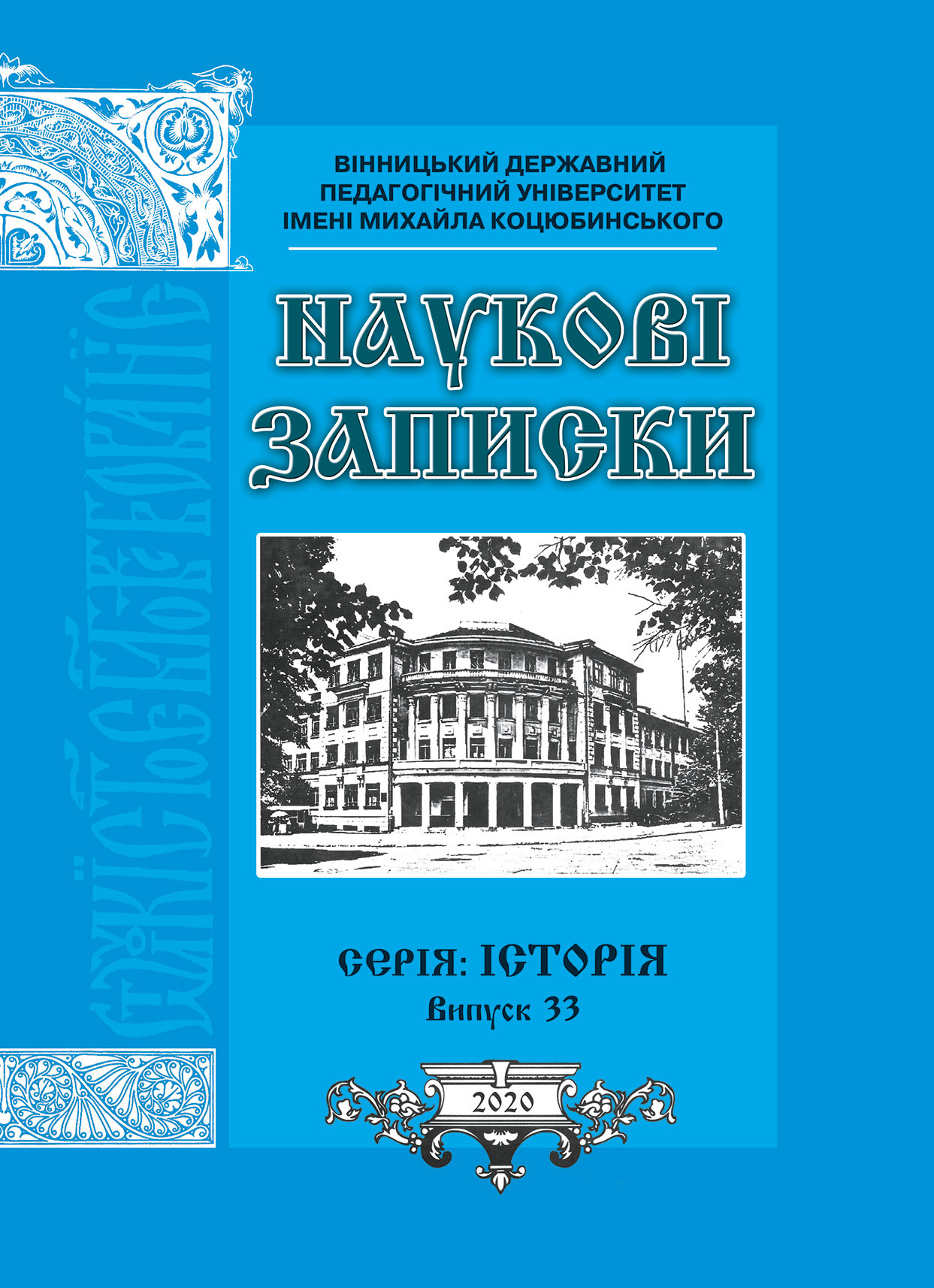Abstract
Purpose. Creating a new territorial structure is planned within the reform of decentralization of Ukraine. All suggested approaches are based on geographical, historical, economic, and transport criteria but do not take into account the specifics of the population identity in the regions. To draw attention to the distinctness of the population in the territories that once belonged to Bratslavshchina. Methods. The theoretical basis of the analysis is the "big man’s frontier" theory, i.e. the frontier theory in Australian rework. Scientific novelty. The distinctness of the Bratslav variant of the Ukrainian frontier lies in the fact that it was here where the main tense confrontation took place between several powerful opponents who laid claims to the Ukrainian lands, which were the Polish–Lithuanian Commonwealth, the Tsardom of Muscovy/the Russian Empire, the Crimean Khanate, and the Ottoman Empire. The struggle around the land issue led to consequences similar to the Australian frontier: large land tenure, long-term predominance of slave labor, popularity of socialist ideas, and the victory of state socialism. This determined such identity traits as the duality of population behavior, i.e. collectivism along with individualism and institutional loyalty along with being prepared to offer resistance. However, the nature of the Bratslav frontier developing seemingly similar features is different. The context of the “land issue” allows us to consider the population identity in these territories under the conditions of the frontier from the property, legal, and ethnographic points of view. Conclusions. Since the analysis was performed only in the context of the land issue, it is necessary to proceed with it taking into account other perspectives, such as religion, customary law, national consciousness in the twentieth century, and collective and historical memory.
References
Fitzpatrick, B. (1947) The Big Man’s Frontier and Australian Farming. Agricultural History, (Vol. 21. № 1), 8–12.
Mamonova, N. (2015) Resistance or Adaptation? Ukrainian Peasants’ Responses to Large-Scale Land Acquisitions. Journal of Peasant Studies. (Т. 42. № 3–4), 607–634.
Rieber, A. (2003) The Comparative Ecology of Complex Frontiers. Imperial Rule / ed. by A. Miller and A. Rieber. Budapest, New York, 178–210.
Szajnocha, K. (1865) Dwa lata dziejów naszych. 1646, 1648 (T. 1). Lwów, 368 с.
Борисевич, С.О. (2009) Законодавче регулювання поземельних відносин та його соціальні наслідки для Правобережної України (1793–1886 роки) (автореф. дис. … д-ра іст. наук : 07.00.01). Київ. 20 с.
Боровиковский, А. (1909). Отчет судьи (в 3 т. Т. 3). Санкт-Петербург. 169 с.
Васильєв, В., Лінн, В. (1997) Колективізація і селянський опір на Україні (листопад 1929 – березень 1930 рр.). Вінниця. 383 c.
Васильчиков, А. И. (1876). Землевладение и земледелие в России и других европейских государствах (в 2 т., T. 2). Санкт-Петербург, 508–1088.
Гайдай, О. Ю. (2015) Радянська спадщина в політиці пам’яті та свідомості населення України 1991‒2014 рр. (на матеріалах Вінницької, Житомирської, Черкаської та Полтавської областей) (автореф. дис. ... канд. іст. наук : 07.00.01). Київ. 17 c.
Гримич, М. (2006) Звичаєве цивільне право українців ХІХ – початку ХХ ст. Київ. 555 с.
Гуржій, І. (1954) Розклад феодально-кріпосницької системи в сільському господарстві України. Київ. 451 с.
Еремин, Н. В. (1913) Опыт разделения Подольской губернии на сельськохозяйтвенные районы. Каменец-Подольск. 43 с.
Киевская губерния (1906). Статистика землевладения 1905 г. Вып. 43. Санкт-Петербург. 56 c.
Комарницький, О. Б. (2002). Містечка Правобережної України і вибори до Всеросійських Установчих зборів. Краєзнавство, (1–4), 86–89.
Криськов, А. А. (2015). Землеволодіння і землекористування в губерніях Правобережної України кінця ХVІІІ – початку ХХ ст. (автореф. дис. … д-ра іст. наук : 07.00.01). Переяслав-Хмельницький. 42 с.
Масненко, В. В. (2018) Як українські селяни стали воїнами (до соціокультурних і мілітарних аспектів революції 1917–1921 рр.). Український селянин, (19), 49–59.
Нагорна, Л. (2008) Регіональна ідентичність: український контекст. Київ. 405 с.
Присяжнюк, Ю. П. (1999). Ментальність українського селянства в умовах капіталістичної трансформації суспільства (друга половина ХІХ – початок ХХ ст.). Український історичний журнал, 3, 23–33.
Списки по всей Подольской губернии лиц, учреждений, обществ, товариществ и компаний, имеющих право участия в выборах земских гласных на трехлетие с 1911 года (1911). Каменец-Подольск. 326 c.
Степанков, В. (1989) Гомоніло Поділля... Прапор Жовтня (Кам’янець-Подільський). 19 лип.
Тригуб, П. М. (2006) Селянство України на виборах до Українських Установчих зборів. Український селянин, (10), 278–281.
Тройницкий, А. (1861) Крепостное население в России по 10-й народной переписи. Санкт-Петербург. 93 с.
Чорновол, І. (2010) Історіографія Австралії у світлі тези Тернера. Регіональна історія України, (4), 239–248.
Чорновол, І. (2015) Компаративні фронтири: світовий і вітчизняний вимір. Київ: Критика. 376 с.

This work is licensed under a Creative Commons Attribution 4.0 International License.
Copyright (c) 2020 Scientific Papers of the Vinnytsia Mykhailo Kotsiubynskyi State Pedagogical University. Series: History





